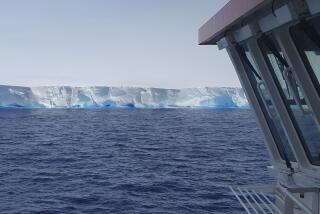Crew Keeps Pinups of Trees, Grass . . . Even Girls : ‘How’s the Weather?’ Not Idle Question in Antarctica
- Share via
MONTEVIDEO, Uruguay — A group of young scientists savored the fresh beef and picturesque atmosphere of a sidewalk cafe in the old port of Montevideo recently, knowing it would be their last taste of civilization for two years.
Hours later, they boarded the research ship Bransfield and sailed south to their new home under the ice at the British Antarctic station of Halley Base, 1,000 miles from the South Pole.
“The lads down there have asked for pictures of trees and grass and women,” said Garry Whitehead, a 22-year-old physics graduate from Barnsley, England. “You miss those sorts of things in the Antarctic.”
Whitehead and his colleagues will join the 19-man team at the base in the Weddel Sea this month on the only visit by a ship in a year.
Two Years Beneath the Mast
For two years, these young Britons will live in a tubular plywood construction just below the surface of the ice shelf, emerging daily to monitor weather conditions in temperatures that average about 75 degrees below zero.
Halley Base is one of five British Antarctic Survey stations where 70 male scientists and staff monitor conditions in one of the world’s most inhospitable regions.
The wind speed, humidity, pressure and other data gathered in the region are crucial to long-term global weather forecasting. The Antarctic acts as a magnet for heat, influencing conditions elsewhere.
The new recruits expect their main problems will be adjusting to the isolation and simultaneous lack of privacy in the cramped conditions of the station. They faced rigorous selection interviews that, apart from their skills, concentrated on their psychological ability to adapt.
“If you are on a base with 19 men for two years it has just got to work,” Whitehead said.
The base itself is comfortable, they say, and the food is good, albeit almost entirely canned or frozen. Fresh milk and eggs will be just a memory.
They expect to spend much of their spare time reading, writing or engaged in hobbies, with photography the most popular. They can look forward to a weekly video tape and a formal dinner every Saturday night.
Weekend evenings also provide an opportunity to indulge in another diversion, “The Goon Show,” named after a British radio comedy of the 1950s. In this version, area bases take part in an airwave free-for-all.
The men are each allowed to send and receive one 200-word telexed letter a month free of charge. They foot the bill for any further personal correspondence.
The young scientists look forward to the opportunity to visit the local penguin colony and travel further afield with tents in summer. In winter, round-the-clock darkness will confine them to base.
‘Not Like the Old Days’
The station is equipped with motorized sleds that take much of the effort out of exploration. “It’s not like the old days. The last dogs left in 1982,” said Mark Row.
The biggest danger at the base is fire, which would rip through the plywood shell. In the event of emergency, two years’ worth of supplies are buried in nearby ice and neighboring stations are ready to help.
The base has a doctor trained in dentistry, surgery and casualty treatment, and he can seek advice over a radio circuit from doctors in Britain.
The young scientists see the job as an adventure and, while realizing that problems lay ahead, were in high spirits before departing.
“We’ve met a lot of people who have been down there,” said Mike Tracy, a 26-year-old from Oxford. “There’s not been one who wouldn’t go down again.”
More to Read
Sign up for Essential California
The most important California stories and recommendations in your inbox every morning.
You may occasionally receive promotional content from the Los Angeles Times.













